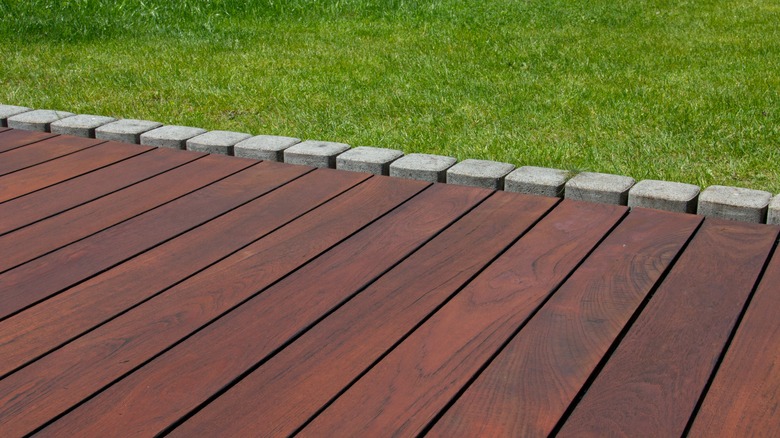When it comes to enhancing outdoor spaces, selecting the right flooring to cover grass areas presents a challenging decision for many. It’s a push and pull between functionality and aesthetics. Choosing a material involves understanding the versatility and adaptability of various flooring solutions to match different outdoor settings, such as gardens, patios, and event spaces. Among the most popular outdoor flooring options are composite and wood decking, outdoor carpets, and WPC interlocking deck tiles, each offering unique benefits and challenges.
Let’s start with an option that generally hits all the marks: composite wood decking. Composite wood decking represents a reliable choice for outdoor flooring over grass, offering a blend of aesthetic appeal, durability, and low maintenance that many homeowners and designers find attractive. Unlike wood, composite decking is made from a mix of wood fibers and plastic polymers, which provides several distinct advantages.
It’s available in a wide range of colors and textures, mimicking the look of natural wood. Additionally, the materials used in composite decking are highly resistant to weathering, decay, and insect damage. It does not warp, crack, or splinter over time, making it ideal for outdoor use with a longer lifespan than traditional wood decking, often lasting 30 to 50 years or more with proper care. In terms of maintenance requirements, a simple cleaning with soap and water will do to maintain its appearance. The only notable con to composite wood decking is the price tag, which can be expensive.
Traditional outdoor flooring options

In contrast, more traditional decking options are cheaper than composite wood decking. Let’s begin with the natural opposite: wood decking. Wood decking adds a warm, natural charm to outdoor spaces that are hard to replicate with synthetic materials. Its natural grain and color variations bring a unique character to patios, decks, and garden areas. It can be stained or painted in various colors, allowing homeowners to customize the look to match their outdoor decor or personal style preferences. Durability and maintenance depend on the type of wood used. Hardwoods like teak, cedar, and ipe wood decking are known for their longevity and resistance, while softer woods may require regular maintenance. This includes cleaning, staining, and/or sealing every few years to protect against moisture and UV damage.
The next best option would be concrete pavers. It is one of the most affordable and versatile solutions for placing over grass, with an easy-to-install, durable, and aesthetic appeal. Ideal for pathways, patios, and seating areas, concrete pavers stand up to heavy foot traffic and require minimal maintenance, making them suitable for residential and commercial spaces. Aesthetically, they provide a wide range of design possibilities, allowing for creative patterns and styles that can complement any landscape or architectural theme. Moreover, if damaged, pavers can be quickly replaced without affecting the surrounding area, ensuring straightforward and cost-effective maintenance. However, a downside to their piece-by-piece nature is that weeds can slip through their cracks and become uneven if not installed correctly.
Modern alternatives
Outdoor carpets offer a modern, stylish, and versatile flooring solution for covering grassy areas, combining ease of installation with aesthetic appeal and practicality. Secure it down to the ground if needed; this can be done with grommets. These carpets come in various colors, patterns, and textures, providing an instant visual upgrade and a cozy atmosphere to outdoor spaces. Made from durable, weather-resistant materials, they are designed to withstand various climates while being easy to maintain, requiring just a simple hose down or sweep to stay clean. Beyond their aesthetic appeal, outdoor carpets provide a softer surface underfoot, enhancing comfort. They are also affordable and appealing to those looking to refresh their outdoor living spaces without a significant investment.
For a DIY-friendly option, WPC (Wood Plastic Composite) interlocking deck tiles offer a modern and convenient solution for covering grassy outdoor spaces. These tiles combine the attributes of wood and plastic, making them an attractive option for quick and easy outdoor flooring. The biggest advantage of these tiles is the ease of installation, as the tiles’ interlocking system means they can be laid down quickly over grass or any level surface without tools or professional assistance. However, it’s important to note that excess moisture can cause some problems, causing the tiles to warp and deteriorate over time, so you’ll need to ensure proper drainage.
Ultimately, there is no one-size-fits-all answer. However, with the right choice, you can transform any grassy area into an outdoor living space that can be enjoyed for years to come.
